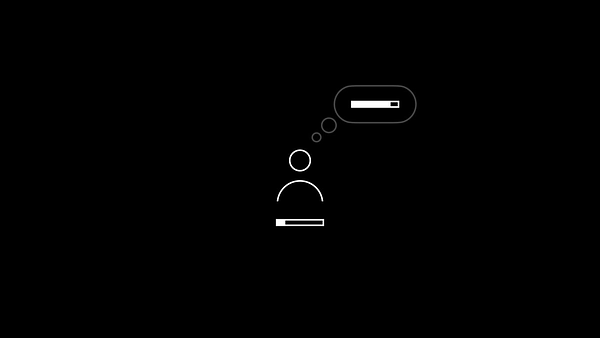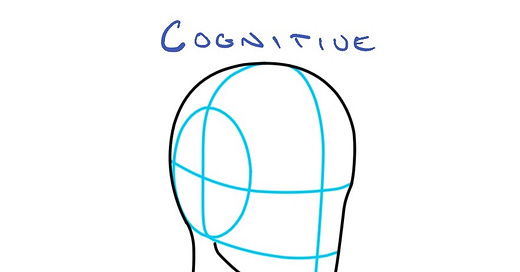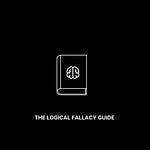Welcome to the 840 new members of the curiosity tribe who have joined us since Friday. Join the 26,411 others who are receiving high-signal, curiosity-inducing content every single week! Oh, and share this on Twitter to help grow the tribe!
Today’s newsletter is brought to you by MicroAcquire!
MicroAcquire is revolutionizing the startup acquisition process. As the #1 startup acquisition marketplace in the world, MicroAcquire provides a platform covering everything you need in order to buy and sell startups. The company recently raised a $6.3 million seed round from a long list of technology entrepreneurs and investors (including this humble newsletter writer!) and is poised for rapid growth.
If you are interested in buying or selling a startup, check out MicroAcquire today!
Today at a Glance
Cognitive biases are systemic errors in thinking that negatively impact decision-making quality and outcomes.
Combatting cognitive biases relies first and foremost on establishing a level of awareness of the biases.
Overview, examples, and combat tactics for common biases, including Dunning-Kruger Effect, Fundamental Attribution Error, Bandwagon Effect, Egocentric Bias, Naïve Realism, Baader-Meinhof Phenomenon, Pygmalion Effect, Confirmation Bias, Backfire Effect, and Anchoring.
The Cognitive Bias Handbook - Part I
Cognitive biases are systemic errors in thinking that negatively impact decision-making quality and outcomes. I recently shared a Twitter thread covering the basics of 20 cognitive biases - but it was admittedly surface-level (280 characters only allows for so much depth and nuance on a topic!).
So here we are. It’s time to dive deeper on cognitive biases, including examples and specific ways to combat each one. To avoid a monstrous newsletter piece that no one has the time to read (or listen to), I will be splitting the coverage of the 20 cognitive biases across 2 newsletters over the coming weeks (with each covering 10 common biases).
This two-part newsletter series will be split as follows:
Part I: Fundamental Attribution Error, Bandwagon Effect, Egocentric Bias, Naïve Realism, Baader-Meinhof Phenomenon, Pygmalion Effect, Confirmation Bias, Backfire Effect, Anchoring, and Dunning-Kruger Effect.
Part II: Ben Franklin Effect, Loss Aversion, Endowment Effect, Availability Bias, Survivorship Bias, Ikea Effect, Hindsight Bias, Plan Continuation Bias, Gambler’s Fallacy, and Curse of Knowledge.
This handbook is designed to be a resource you can save and come back to whenever you need a refresher. Without further ado, let’s dive into Part I…
Dunning-Kruger Effect
What is it?
The Dunning-Kruger Effect says that people with a low objective ability at a task are prone to overestimate their ability at that task.
Humans are notoriously incapable of objective evaluation of themselves, including of their competency levels.
(Note: see below for a deep-dive thread I wrote on Dunning-Kruger!)


Examples
“Everyone is a genius in a bull market.”
This is a common phrase heard in the investment world during bull markets. When everyone is making money, everyone starts to fancy themselves expert investors. They fail to separate their objective skill at the task from the outcomes.
If you start hearing more and more people bragging about their stock market prowess, the market is entering the danger zone.
How do you combat it?
Several tactical strategies for combatting the Dunning-Kruger Effect:
Identify your circle of competence: Know what you know, and what you don’t.
Get comfortable with “I don’t know”: Most people are afraid of this phrase. Get comfortable with it.
Challenge yourself: Consistently challenge your belief on your own competency ratings. Do you actually know something as well as you think you do? What would an unbiased third-party say?
It will feel uncomfortable - you’ll be challenging your most basic instincts. If you persist, you’ll be less prone to falling victim to the Dunning-Kruger Effect.
Fundamental Attribution Error
What is it?
Fundamental Attribution Error (or “FAE” for short) is the human tendency to hold others accountable (while giving ourselves a break).
It says that humans will tend to:
Attribute the actions of others to their character (and not to their situation or context).
Attribute our own actions to situation and context (and not to our character).
Why do we do this? Well, as with many of the biases we will cover, it likely developed as a heuristic (a problem-solving or decision-making shortcut), in this case for simplifying the process and judgement around new human relationships.
From an evolutionary perspective, quickly attributing negative actions to character (rather than situation or context) may have kept you alive, as you’d be more likely to avoid that individual.
But in a modern context, being prone to FAE can create real problems.
Examples
The workplace is a common FAE breeding ground.
It is easy to form perspectives on the character of colleagues and bosses based on small pieces of information. If a colleague arrives late for work, they are lazy, right? This is clearly a flawed line of thinking, as there are numerous factors that could have contributed to your colleague’s lateness.
The reality is that, in these instances, you are using limited information to create an overall picture of an individual. This is the equivalent of seeing one square of a map and believing you know the map in its entirety.
How do you combat it?
The first step to combatting FAE (and all cognitive biases, for that matter!) is awareness. Keep it in mind as you build a body of experiences with new colleagues or acquaintances.
Beyond awareness, combatting FAE comes down to forcing yourself to slow down and evaluate the potential circumstances or situational factors that may be influencing an individual’s actions or behaviors. You won’t always have the time to do so (heuristics can be helpful!), but with more lasting relationships (friends, partners, colleagues, etc.), it is worth the extra effort.
You’ll build deeper, more trusting relationships (and naturally become a more compassionate person).
Bandwagon Effect
What is it?
Humans evolved as a social species. Our communities and collective behavior allowed us to thrive.
But our nature has a downside…
It creates a strong tendency to speak, act, or believe things simply because a lot of other people do. The Bandwagon Effect says that we prefer actions that many others are taking, irrespective of the logic or soundness of those actions.
Our social nature subconsciously pushes us towards fitting in, leading to mindless actions and dangerous groupthink.
Examples
The classic example of Bandwagon Effect is from a popular old TV show, Candid Camera, in which unknowing participants were caught on hidden cameras doing funny things.
In one episode, people entered an elevator to find several people (actors) standing facing the back wall. Rather than question the behavior, many of the elevator entrants simply mimicked the behavior, despite its absurdity.
The Bandwagon Effect is all around us - in investing (FOMO and meme stocks, anyone?!), politics (sigh…), business (companies blindly following the strategies of competitors), and more.
Once you learn it, you’ll start seeing it all around you.
How do you combat it?
There are two effective ways to combat the Bandwagon Effect:
Ground your actions and behaviors in a set of core principles and values. Establish your principles and values clearly - write them down, vocalize them regularly. Use them as a foundation for your actions and behaviors. Before taking any (meaningful or significant) action, ask yourself: Does this meet the burden of my principles and values or am I simply following the crowd?
Leverage first principles thinking (or a simplified version of it) to determine if a given action actually makes sense. Is the action grounded in sound logic or flawed assumptions? React and change course accordingly.
Neither one is perfect, but both will help you avoid becoming a blind follower.
Egocentric Bias
What is it?
Technically speaking, Egocentric Bias is a broad category of cognitive biases. In this case, however, I am specifically focused on one: the human tendency to have a higher view of one's self than is objectively warranted.
Examples
Have you ever worked on a group project and felt like you carried the entire team on your back? Well, you may be exhibiting Egocentric Bias.
In group activities, we tend to overestimate (in comparison to truly objective measure) the degree and value of our own contributions relative to others.
How do you combat it?
First off, recognize when your thought patterns are becoming egocentric. When you find yourself thinking in an egocentric manner, the best way to fight back is to separate from yourself.
Try to become the objective third-party in evaluating your own performance and that of others.
Easier said than done, but the ability to objectively evaluate performance is a common trait among the world’s top performers. Learn from the best: Listen to Tom Brady interviewed after a loss - you’ll hear this objectivity in action.
Naïve Realism
What is it?
Naïve Realism is a cognitive bias that can be broadly grouped under the category of egocentric biases.
Specifically, Naive Realism has two main pillars:
We tend to believe that we see the world with perfect objectivity (cognitive biases be damned!).
We assume that people who disagree with us must be ignorant, uninformed, or biased.
It can often lead to a dangerous “Bias Blind Spot” - a phenomenon in which we accurately identify cognitive biases in others but are unable to identify them in ourselves.
Examples
The famous example of Naïve Realism is an experiment involving a highly-contested Dartmouth vs. Princeton football game. Fans of each side were asked to watch the film of the game, but depending on which side they were on, they saw a very different game.
Dartmouth fans perceived the number of Princeton infractions as much higher; Princeton fans perceived the number of Dartmouth infractions as much higher.
The groups were incapable of objectivity, despite vocalizing their objectivity to the researchers. They watched the same game, but it was as if they didn’t.
How do you combat it?
This is a tough one, as it is so deeply-rooted in our minds as a protective mechanism.
Again, awareness is the key. Embrace yourself as a flawed creature - recognize that you have the same (or at least similar) blind spots and deficiencies as others.
Baader-Meinhof Phenomenon
What is it?
Ever notice that something you just learned seems to pop up everywhere around you? The Baader-Meinhof Phenomenon (also called the “Frequency Illusion”) says that increased awareness of something creates the illusion that it is appearing more often.
You see something once and immediately become more likely to notice it the next time it appears, which reinforces your perception that it is constantly appearing in front of you.
Examples
How often do you look at the clock and see 11:11? It feels like all the time, right? Just one simple example of the Baader-Meinhof Phenomenon in action.
You see a lot of times on your clock, but only mentally register it when it reads 11:11, which further cements the illusion that you only look at the clock at 11:11.
Brands often seek to exploit the Baader-Meinhof Phenomenon in their marketing campaigns in an attempt to create an illusion of scale, reach, and omnipresence.
How do you combat it?
When you start to feel like you are seeing something everywhere, take a step back and observe its actual frequency relative to a given baseline.
In the low-stakes example of the clock, make a note every time you look at the clock and it isn’t 11:11.
Pygmalion Effect
What is it?
The Pygmalion Effect is named after the Greek myth of Pygmalion - a sculptor who fell in love with his own statue. It says that high expectations lead to higher and improved performance (and low expectations lead to lower and deteriorated performance).
The phenomenon was first discovered by psychologist Robert Rosenthal, who applied it to teachers and children in finding that children who had high expectations vocalized to them were more likely to experience improved performance relative to their peers.
Those who have high expectations placed on them are more likely to internalize these expectations and improve their performance accordingly. Similarly, those who have low expectations placed on them are more likely to internalize these expectations and weaken their performance accordingly.
Examples
The Pygmalion Effect, while somewhat disputed, appears across the business and educational landscapes.
CEOs and business leaders will often seek to leverage the phenomenon, vocalizing high expectations to their teams in an effort to drive up performance.
In education, far too many children have been “left behind” by the educational system when low expectations were placed upon them, leading to a self-fulfilling prophecy of deteriorating performance.
How do you combat it?
On the positive end (when high expectations improve performance), it is not necessarily a bias we want to combat. On the negative end, it definitely is.
As a leader, the most critical step is simple: Stop vocalizing low expectations. If they are known to have a potential negative impact, they have no use in your organization.
As a follower, if low expectations are vocalized to you, fight back. Don’t let someone else set your path. You are the captain of your own ship.
Confirmation Bias
What is it?
One of the most common cognitive biases, Confirmation Bias says that humans have a tendency to see and interpret information in a manner that supports previously held beliefs.
We systematically ignore evidence that negates our beliefs and embrace evidence that confirms them. As a result, we fail to see the world as it is (and instead see it how we want to see it).
Allowing Confirmation Bias to create and inform our world view is the “blue pill” - rejecting it is the “red pill”.
Examples
Imagine you’re starting a new company. You have a hypothesis about the way the world should work that is different from how it works today. You start gathering data. If the new data is positive, you say this idea is a slam dunk! If the new data is negative, you say there must have been an error in the experiment.
Stop me if you’ve seen this movie before…
How do you combat it?
Actively look for ways to challenge your beliefs. In investment terms, find the “bear case” for any closely held belief.
Ask yourself questions:
Why am I wrong?
What would I have to learn to completely change my mind on this topic?
Always seek information from a diverse range and spectrum of sources.
Backfire Effect
What is it?
The Backfire Effect is a hyper-pronounced version of Confirmation Bias. It is the tendency for humans to use evidence in direct conflict with their thesis to further strengthen their previously held beliefs. New information that disproves a thesis actually further cements the belief in that thesis.
You can remember it as the “dig in your heels” phenomenon.
Examples
The world of politics is rife with examples of the Backfire Effect in action. It’s the reason people don’t like to discuss politics at dinner parties - for every point one person makes, it seems the other person becomes more and more stubbornly certain of their own belief.
And before you go pointing fingers, remember: This is a human cognitive bias, it does not discriminate based on political party or affiliation.
How do you combat it?
Combatting the Backfire Effect requires the same approach as with Confirmation Bias (albeit scaled up in intensity!).
Most importantly, if you catch yourself digging in your heels on a topic, ask yourself why you are doing so. Have you done the work to be definitively correct on a topic? Are there alternatives that you have not considered? Be ruthlessly honest with yourself in order to fight back.
Anchoring
What is it?
Anchoring is a cognitive bias that is all about reference points. The "anchor" is a reference point of information - usually the first piece of information received on a topic. All subsequent thinking or decisions are silently "anchored" to this point.
Examples
Anchoring has been proven by scientists (and used car salesmen) time and again.
If you enter a negotiation, the starting point for the negotiation has an outsized influence on the landing point. This can be used for you (when negotiating your salary at a new job, start higher than feels reasonable!) or against you (when negotiating a car price, the salesman will start higher than feels reasonable), but it is always impactful.
How do you combat it?
Hyper-awareness of “anchors” is the best way to combat the impact of Anchoring Bias.
If you are the “protagonist” in a negotiation (i.e. the person opening the negotiation), awareness of the power of anchors will make you more likely to land in an agreeable spot.
If you are on the other side, do your homework in advance. Come in with strong, evidence-backed views on the ends of the spectrum and where you would like to land. Don’t allow the opening salvo to impact your evidence-backed views.
So that does it for Part 1 of The Cognitive Bias Handbook, covering Dunning-Kruger Effect, Fundamental Attribution Error, Bandwagon Effect, Egocentric Bias, Naïve Realism, Baader-Meinhof Phenomenon, Pygmalion Effect, Confirmation Bias, Backfire Effect, and Anchoring.
Stay tuned for Part 2, which will cover Ben Franklin Effect, Loss Aversion, Endowment Effect, Availability Bias, Survivorship Bias, Ikea Effect, Hindsight Bias, Plan Continuation Bias, Gambler’s Fallacy, and Curse of Knowledge.
The Bloomboard - Featured Opportunities
Pesto Tech - Account Executive
Pallet - Full Stack Software Engineer
Beyond Protocol - Director of Ops, Director of Business Development
Metafy - Senior Product Designer, Senior Technical Recruiter
Panther - Customer Delight Manager
Avicado - Marketing Manager, Data Consultant
Commonstock - Community Manager, Marketing Designer
Atreides Management - Data Analyst
Synthesis - Head of People, VP Growth, Technical Recruiter
The full board can be found here!
We have had a bunch of hires through the board and the results for featured roles have been insane (one role had 200+ applications in 1 week)! If you are a high-growth company in finance or tech, you can use the “Post a Job” button to get your roles up on the board and featured in future Twitter and newsletter distributions.
That does it for today. Join the 26,411 others who are receiving high-signal, curiosity-inducing content every single week! Until next time, stay curious, friends!
















Share this post